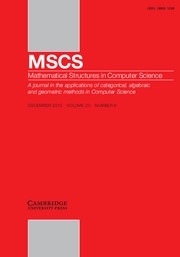Crossref Citations
This article has been cited by the following publications. This list is generated based on data provided by Crossref.
Lellmann, Björn
and
Pattinson, Dirk
2011.
Automated Reasoning with Analytic Tableaux and Related Methods.
Vol. 6793,
Issue. ,
p.
211.
Straßburger, Lutz
2012.
Extension without cut.
Annals of Pure and Applied Logic,
Vol. 163,
Issue. 12,
p.
1995.
Dunchev, Cvetan
Leitsch, Alexander
Rukhaia, Mikheil
and
Weller, Daniel
2015.
Logic, Language, and Computation.
Vol. 8984,
Issue. ,
p.
117.
Aceto, Luca
Crescenzi, Pierluigi
Ingólfsdóttir, Anna
and
Mousavi, Mohammad Reza
2023.
The Way We Were: Structural Operational Semantics Research in Perspective.
Electronic Proceedings in Theoretical Computer Science,
Vol. 387,
Issue. ,
p.
26.


